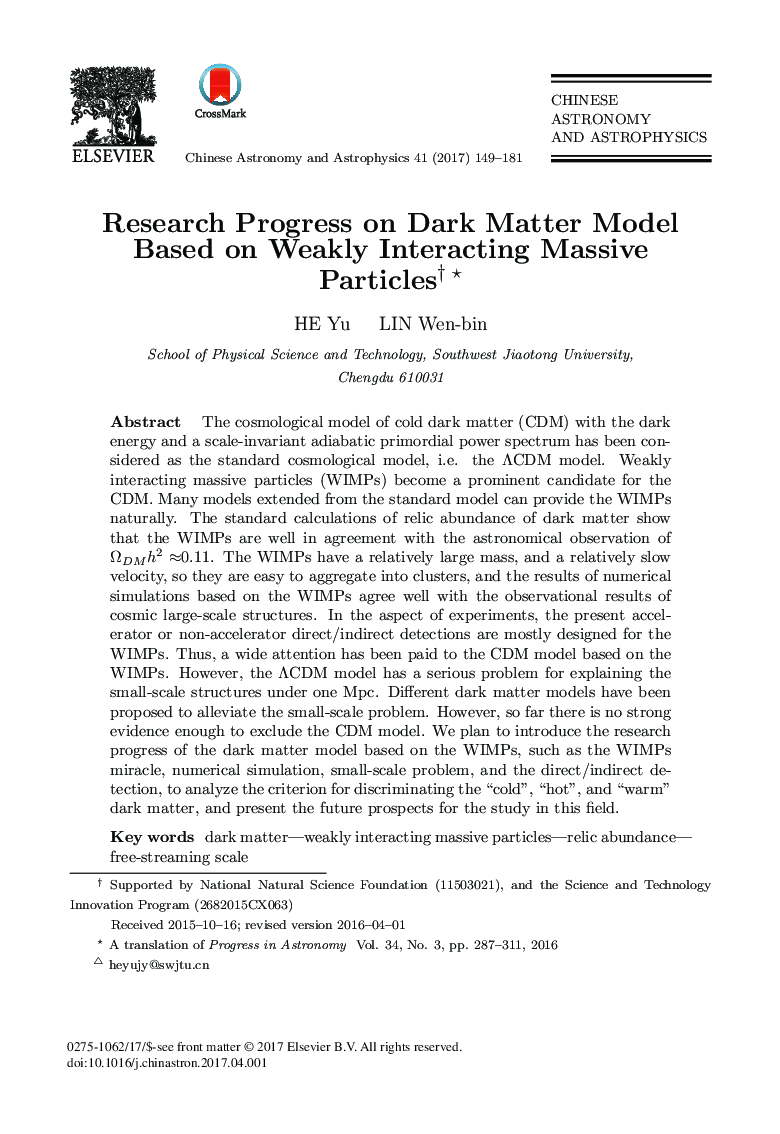| کد مقاله | کد نشریه | سال انتشار | مقاله انگلیسی | نسخه تمام متن |
|---|---|---|---|---|
| 8133285 | 1523413 | 2017 | 33 صفحه PDF | دانلود رایگان |
عنوان انگلیسی مقاله ISI
Research Progress on Dark Matter Model Based on Weakly Interacting Massive Particles
ترجمه فارسی عنوان
پیشرفت تحقیق در مدل ماده تاریک بر اساس ذرات عظیم درهم آمیز است
دانلود مقاله + سفارش ترجمه
دانلود مقاله ISI انگلیسی
رایگان برای ایرانیان
کلمات کلیدی
ماده تاریک، ضعیف شدن ذرات عظیم، فراوانی سرچشمه، مقیاس آزاد جریان،
موضوعات مرتبط
مهندسی و علوم پایه
فیزیک و نجوم
نجوم و فیزیک نجومی
چکیده انگلیسی
The cosmological model of cold dark matter (CDM) with the dark energy and a scale-invariant adiabatic primordial power spectrum has been considered as the standard cosmological model, i.e. the ÎCDM model. Weakly interacting massive particles (WIMPs) become a prominent candidate for the CDM. Many models extended from the standard model can provide the WIMPs naturally. The standard calculations of relic abundance of dark matter show that the WIMPs are well in agreement with the astronomical observation of ΩDM h2 â0.11. The WIMPs have a relatively large mass, and a relatively slow velocity, so they are easy to aggregate into clusters, and the results of numerical simulations based on the WIMPs agree well with the observational results of cosmic large-scale structures. In the aspect of experiments, the present accelerator or non-accelerator direct/indirect detections are mostly designed for the WIMPs. Thus, a wide attention has been paid to the CDM model based on the WIMPs. However, the ÎCDM model has a serious problem for explaining the small-scale structures under one Mpc. Different dark matter models have been proposed to alleviate the small-scale problem. However, so far there is no strong evidence enough to exclude the CDM model. We plan to introduce the research progress of the dark matter model based on the WIMPs, such as the WIMPs miracle, numerical simulation, small-scale problem, and the direct/indirect detection, to analyze the criterion for discriminating the “cold”, “hot”, and “warm” dark matter, and present the future prospects for the study in this field.
ناشر
Database: Elsevier - ScienceDirect (ساینس دایرکت)
Journal: Chinese Astronomy and Astrophysics - Volume 41, Issue 2, AprilâJune 2017, Pages 149-181
Journal: Chinese Astronomy and Astrophysics - Volume 41, Issue 2, AprilâJune 2017, Pages 149-181
نویسندگان
He Yu, Lin Wen-bin,
